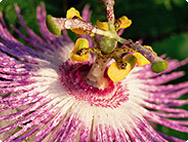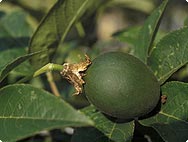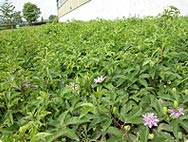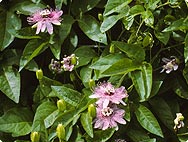
Passiflora incarnata L.
Passion Flower

History
The passion flower was well
known to the natives of South American as a herbal remedy. The plant was also
often used in Brazilian medicinal folklore. The passion flower was discovered by
the Spanish doctor, Monardes in Peru in 1569. Forty years later, it was
introduced to Europe as an ornamental plant, for, long before the passion flower
was included in the Europe's treasury of medicinal plants, botanists were
fascinated by this climber's inflorescence. In his book De florum cultura,
published in 1633, the Jesuit Ferrari saw in the various parts of the flower all
of the instruments of the Passion of Jesus Christ:
the three-lobed leaves
represent the spear,
the tendrils the scourge,
the three styles the
nails of the cross,
the stigma represent the sponge steeped in vinegar,
the corona at the centre of the blossoms resemble the Crown of Thorns,
the ovaries on a stalk represent the chalice,
the five stamens the five
wounds
and the stemmed ovary (androgynophore) the cup or - according to
other interpretations - the post to which Christ was bound during the
flagellation.
The Jesuits also gave the passion flower its Latin name, which
is made up of the words passio or 'suffering', flos, the 'flower' and incarnata
which means 'to make flesh', re-incarnation respectively.
The passion flower
began to be used as a herbal remedy in the second half of the last century and
was introduced via American homoeopathy. It is a well known sedative in low
doses. The remedy's cardiotonic properties were only recognised in
France and in Switzerland. During the First World War it was used as a nerve
sedative to treat shell-shock.

Botanical characteristics
This perennial climber has thick, fleshy, very long roots. The rhizome and the roots bear numerous vertically-striped shoots that can grow to a length of up to 10 m. The leaves comprise three deep lobes with single serrated edges while, underneath, the leaves are covered in fine hairs. There are knob-shaped extra-floral nectaries on the leaf blades. The leaves are arranged alternately on long stems. At each axil there are small secondary leaves, fine, corkscrew-like tendrils, and a single flower, also on a long stem.These unique blossoms are about 8 cm in diameter and have five large sepals which are green on the outside and white inside; these sepals alternate with five white petals of roughly the same size. Inside the petals are several corona of fine threads which radiate out from the centre; these corona are white inside and tinged with violet on the outside and prevent small insects from getting to the nectar. The three oval, serrated petal leaves spread out horizontally and grow together at their origin to form a cup-shaped floral base. This base grows into a central pillar of about 1cm in height and supports the egg-shaped ovary on three broadly-splayed styles which each have a head-shaped stigma at the end; underneath these styles are five filaments which splay out in a curve. The sweet-scented flowers are only open for one or two days at the most.In the autumn the ovary ripens into an egg-shaped, yellowish green to pale orange berry. The fruit, which is edible if rather bland, is around 6 cm in size and contains many seeds folded over each other which are surrounded by the fruit's sweet pulpy flesh. The species Passiflora edulis (maracuja, purple granadilla) is valued for its culinary uses as a supplier of passion fruit and is used to create fruit juice or fruit-flavoured yoghurts; it is also simply sliced open and eaten with a spoon.The flower blossoms from July to September.

Habitat
The over 400 species of the Passiflora family are to be found in a primarily tropical habitat; for this reason this plant is nowadays a highly endangered species. Most of the species were found originally in the Southern States of the USA as well as in Central and South America. Botanists and plant lovers were responsible for the worldwide dissemination of the plant early on, so that today, species of the plant can be found in all tropical and subtropical parts of the world. Some species are less sensitive to cold weather and can survive European winters, provided it is growing in a frost-free area. For this reason the plant can sometimes be found growing wild. Nowadays it is produced from specially grown crops. The main areas of cultivation are in India, Florida, Italy and Spain.

Preparation
A.Vogel/Bioforce
makes use of the parts of the fresh, organically grown Passiflora incarnata
plant that are above ground. The plant is harvested whilst it is in bloom. An
alcoholic extract is produced which, depending on use, is also shaken
(succussed) in a homeopathic dilution.Sometimes other species of Passiflora
appear in the herbal industry. It is not easy to differentiate between these
species and necessitates careful microscopic and chromatographic scrutiny.
According to Ph.Helv.VII, it should not contain any amount of P. caerulea, since
this contains a relatively high amount of cyanogenic glycosides which provoke
enzymatic breakdown and the production of hydrocyanic
acid.
A.Vogel Blog – Natural and Healthy
Inspiration for a healthy life!
HERBAMARE SOUP-ER SOUPS!
DOWNLOAD YOUR FREE RECIPE BOOKLET!
8 healthy, hearty and delicious homemade soups.
Supporting a healthier happier you
“Nature is just about the best thing we’ve got!“
Alfred Vogel's guide to leading a healthy and happy life
Healthy & nutritious dinner ideas
Get new recipes in your inbox every month. Sign up now